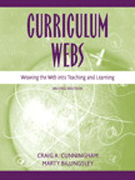Curriculum Webs - more homework needed
By Murray Bourne, 08 Mar 2006
"Weaving the Web into Teaching and Learning"
Cunningham, C and Billingsly, M © 2006 Pearson

Summary Review
I'm not going to write much about this book because basically, I was not impressed.
The problems:
- The book is disorganised - it is neither a coherent treatise on Web design nor on teaching and learning. It mixes the two aspects, leaving (I strongly suspect) the novice reader somewhat bewildered.
- Chapter 4, "Laying Out an Effective Web Page" dives into simple HTML first. While I believe educators should have a knowledge of basic HTML, you don't start there. You encourage the reader to use some WYSIWYG tool and spend most of their time thinking about learner effectiveness. The HTML (and CSS) should come a lot later.
- Right from the first page, and throughout, the authors raved about all the resources to be found on the "companion site". But there is nothing at that site at all - you just get a 403 Forbidden error.
Sheesh - what is that? Checking Google's cache of the site, I was greeted with some text-only pages copied straight from the book, some assorted badly formatted pages (also from the book). Around this point I gave up on this futile exercise.
If the book is all about effective Web design and they cannot even organise their own companion website, what are they playing at?
More homework is needed on the author's part.
Recommendation: Save your money - there are plenty of better e-learning/Web design books out there.
See the 4 Comments below.
13 Nov 2006 at 12:34 am [Comment permalink]
Try the companion site now.
I had a class in which I created (the beginnings of) a curriculum web and I found the book quite useful. I am a high school Mathematics teacher (51 years old) and was just reentering the college world (after over 20 years away from it) when I took the course and used this book.
Can you tell me about some other "better e-learning/Web design books out there" regarding the specific design of "curriculum webs" and "web quests"?
16 Nov 2006 at 7:53 am [Comment permalink]
Thanks, A.M.
Yes, I tried the companion site and did find it useful - thanks for the update.
I don't know that I have come across too many "curriculum webs" books, but I liked these 2 e-learning books. Here are my summary/reviews:
Making Sense of Online Learning
Designing World Class e-Learning
As for webquests, I use Bernie Dodge's site as my main reference.
Tell me more about your math curriculum web development - it sounds interesting.
28 Sep 2007 at 2:42 pm [Comment permalink]
As the author, I don't present an unbiased view. However, the decision to weave discussion of web design and curriculum design into one book was quite intentional. People who want a book that does only one or the other have lots of options; I believe ours is the only one to combine the two in the way we do.
You have to understand, this book is aimed at a particular niche: the intersection of technology and education. As written in many thoughtful books on this subject, knowing a lot about technology or knowing a lot about education does not necessarily mean that you know a lot about how to effectively integrate technology into teaching and learning. This book does, I think, a credible job of doing just that.
One more comment: we DO introduce HTML in the book, and feel that an understanding of HTML is important to using the WYSIWYG editors. If you read the book carefully, you see that we have developed "hands on lessons" that teach the major WYSIWYG editors. Doing the hands on lessons concurrently with the book (there is a lesson for each chapter) means you will have enough WYSIWYG experience before you come to the HTML in chapter 4.
29 Sep 2007 at 1:15 am [Comment permalink]
Hi Craig and thanks for your response.
I agree with you on:
* "knowing a lot about technology or knowing a lot about education does not necessarily mean that you know a lot about how to effectively integrate technology into teaching and learning"
and
* "an understanding of HTML is important to using the WYSIWYG editors" (although I would say 'helpful' rather than 'important')
I'm not sure why you have capitalised "do" in the first line of your last paragraph since I did mention the inclusion of HTML in the book.
I do remember the "hands on lessons" but I don't recall them coming earlier in the book, before Chapter 4.
The accompanying website: To be fair, I checked out curriculumwebs.com again just now. It all seems to work, but it is unfortunate that it uses an image- and frames-based navigation system, which is unfriendly from both a user point of view and a search engine point of view.
Yes, I DO understand that "this book is aimed at a particular niche: the intersection of technology and education". I am well and truly in that niche.
My conclusion remains: more homework needed.